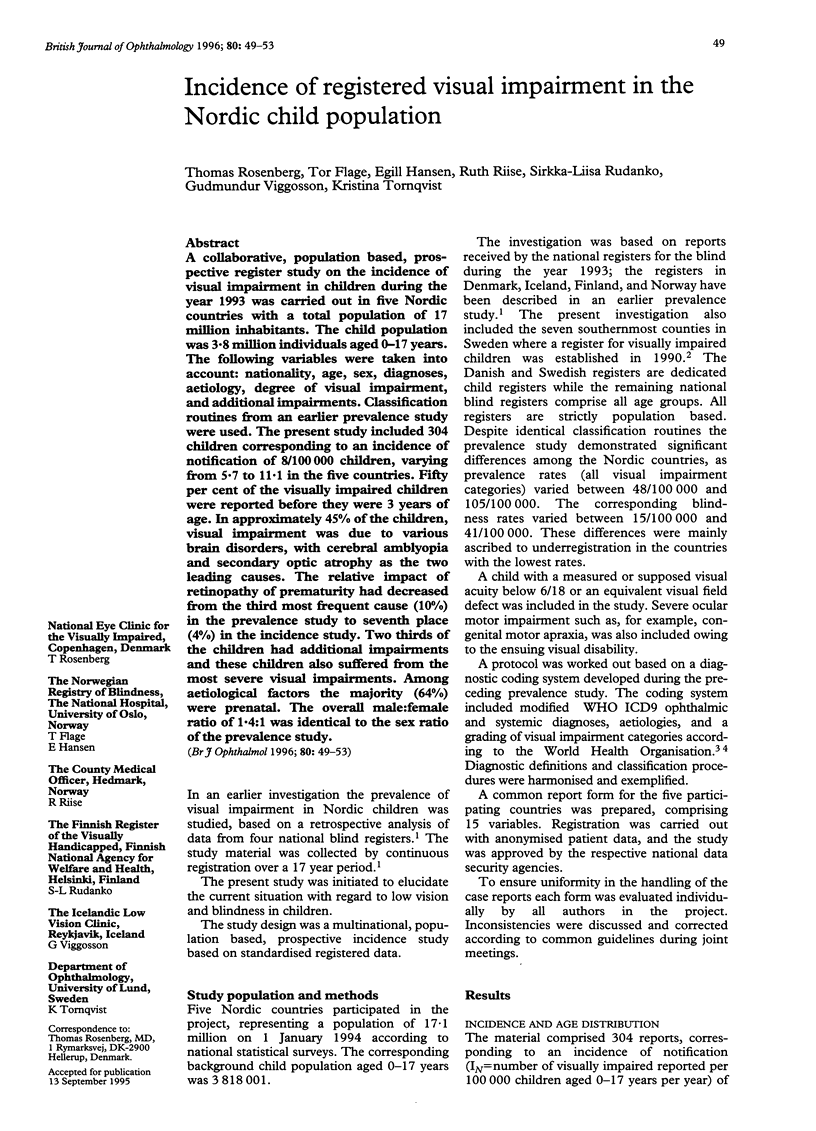Abstract
A collaborative, population based, prospective register study on the incidence of visual impairment in children during the year 1993 was carried out in five Nordic countries with a total population of 17 million inhabitants. The child population was 3.8 million individuals aged 0-17 years. The following variables were taken into account: nationality, age, sex, diagnoses, aetiology, degree of visual impairment, and additional impairments. Classification routines from an earlier prevalence study were used. The present study included 304 children corresponding to an incidence of notification of 8/100,000 children, varying from 5.7 to 11.1 in the five countries. Fifty per cent of the visually impaired children were reported before they were 3 years of age. In approximately 45% of the children, visual impairment was due to various brain disorders, with cerebral amblyopia and secondary optic atrophy as the two leading causes. The relative impact of retinopathy of prematurity had decreased from the third most frequent cause (10%) in the prevalence study to seventh place (4%) in the incidence study. Two thirds of the children had additional impairments and these children also suffered from the most severe visual impairments. Among aetiological factors the majority (64%) were prenatal. The overall male:female ratio of 1.4:1 was identical to the sex ratio of the prevalence study.
Full text
PDF




Selected References
These references are in PubMed. This may not be the complete list of references from this article.
- Causes of severe visual impairment in children and their prevention. Doc Ophthalmol. 1975 Dec 30;39(2):213–341. [PubMed] [Google Scholar]
- Foster A. Childhood blindness. Eye (Lond) 1988;2 (Suppl):S27–S36. doi: 10.1038/eye.1988.131. [DOI] [PubMed] [Google Scholar]
- Good W. V., Jan J. E., DeSa L., Barkovich A. J., Groenveld M., Hoyt C. S. Cortical visual impairment in children. Surv Ophthalmol. 1994 Jan-Feb;38(4):351–364. doi: 10.1016/0039-6257(94)90073-6. [DOI] [PubMed] [Google Scholar]
- Hansen E., Flage T., Rosenberg T., Rudanko S. L., Viggosson G., Riise R. Visual impairment in Nordic children. III. Diagnoses. Acta Ophthalmol (Copenh) 1992 Oct;70(5):597–604. doi: 10.1111/j.1755-3768.1992.tb02139.x. [DOI] [PubMed] [Google Scholar]
- Hatfield E. M. Blindness in infants and young children. Sight Sav Rev. 1972 Summer;42(2):69–89. [PubMed] [Google Scholar]
- Lindstedt E. Severe visual impairment in Swedish children. Doc Ophthalmol. 1972 Apr 15;31(1):173–204. doi: 10.1007/BF00167366. [DOI] [PubMed] [Google Scholar]
- Riise R., Flage T., Hansen E., Rosenberg T., Rudanko S. L., Viggosson G. Visual impairment in Nordic children. IV. Sex distribution. Acta Ophthalmol (Copenh) 1992 Oct;70(5):605–609. doi: 10.1111/j.1755-3768.1992.tb02140.x. [DOI] [PubMed] [Google Scholar]
- Riise R., Flage T., Hansen E., Rosenberg T., Rudanko S. L., Viggosson G., Warburg M. Visual impairment in Nordic children. I. Nordic registers and prevalence data. Acta Ophthalmol (Copenh) 1992 Apr;70(2):145–154. doi: 10.1111/j.1755-3768.1992.tb04118.x. [DOI] [PubMed] [Google Scholar]
- Rosenberg T. Visual impairment in Danish children 1985. Acta Ophthalmol (Copenh) 1987 Feb;65(1):110–117. doi: 10.1111/j.1755-3768.1987.tb08500.x. [DOI] [PubMed] [Google Scholar]
- Williamson W. D., Desmond M. M., Andrew L. P., Hicks R. N. Visually impaired infants in the 1980s. A survey of etiologic factors and additional handicapping conditions in a school population. Clin Pediatr (Phila) 1987 May;26(5):241–244. doi: 10.1177/000992288702600505. [DOI] [PubMed] [Google Scholar]


